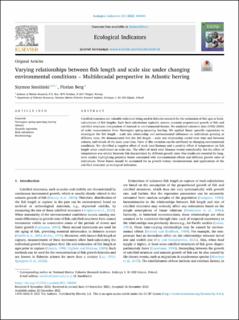Varying relationships between fish length and scale size under changing environmental conditions – Multidecadal perspective in Atlantic herring
Peer reviewed, Journal article
Published version
Permanent lenke
https://hdl.handle.net/11250/2999563Utgivelsesdato
2022Metadata
Vis full innførselSamlinger
- Articles [3012]
- Publikasjoner fra CRIStin [3070]
Sammendrag
Calcified structures are valuable indicators being used in fisheries research for the estimation of fish ages or back-calculations of fish lengths. Such back-calculations typically assume constant proportional growth of fish and calcified structures independent of internal or environmental factors. We analyzed extensive data (1935–2020) of scale measurements from Norwegian spring-spawning herring. We applied linear quantile regressions to investigate the fish length – scale size relationship and environmental influences on individuals growing at different rates. We demonstrated that the fish length – scale size relationship varied over time and between cohorts, individuals of the same year-class. Parts of this variation can be attributed to changing environmental conditions. We identified a negative effect of stock total biomass and a positive effect of temperature on fish length when conditioned on scale size. The effect of stock total biomass varied considerably but the effect of temperature was similar between fish characterized by different growth rates. Our results are essential for long-term studies highlighting potential biases associated with environmental effects and different growth rates of individuals. These biases should be accounted for in growth history reconstructions and applications of the calcified structures as ecological indicators.
